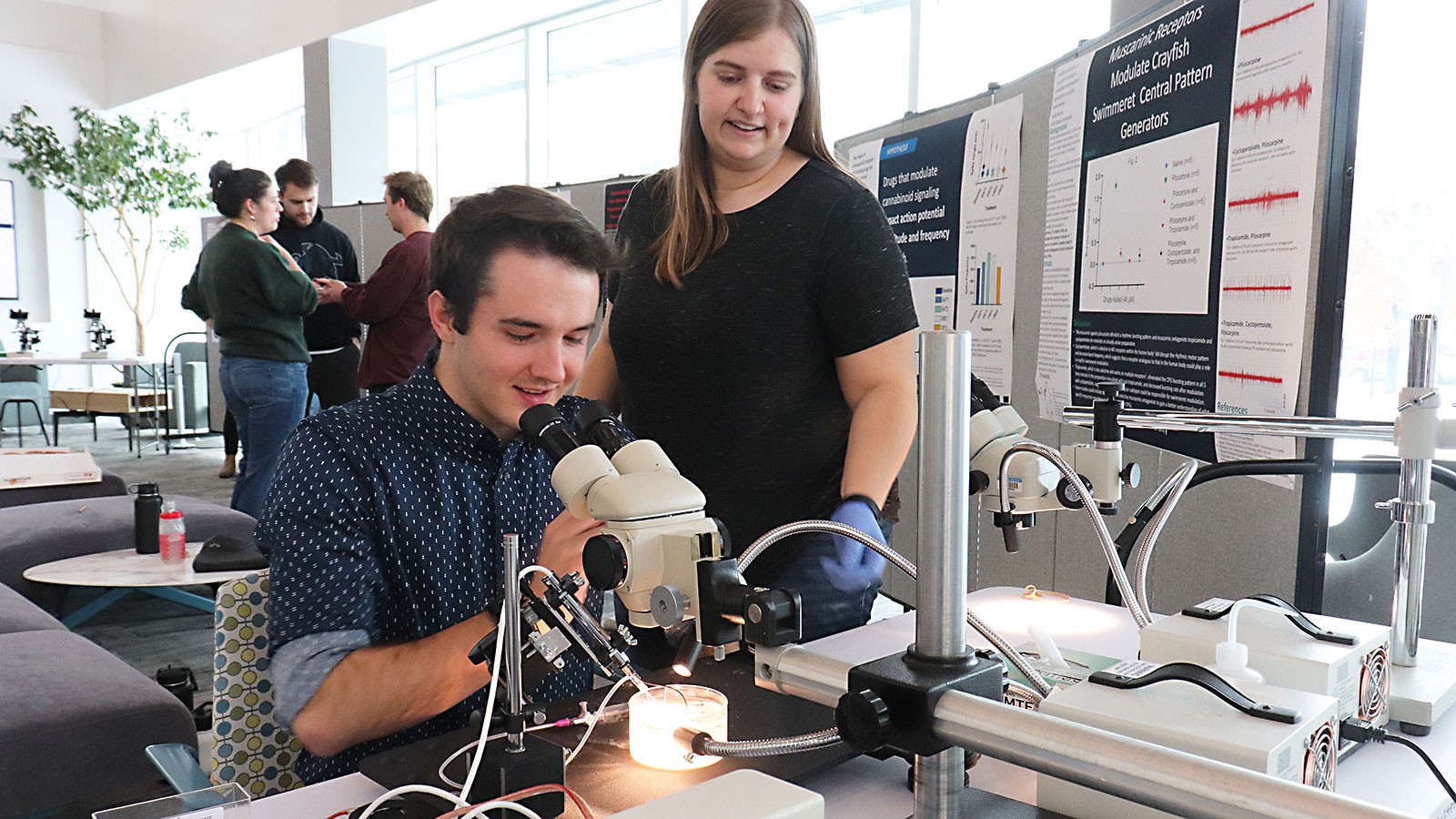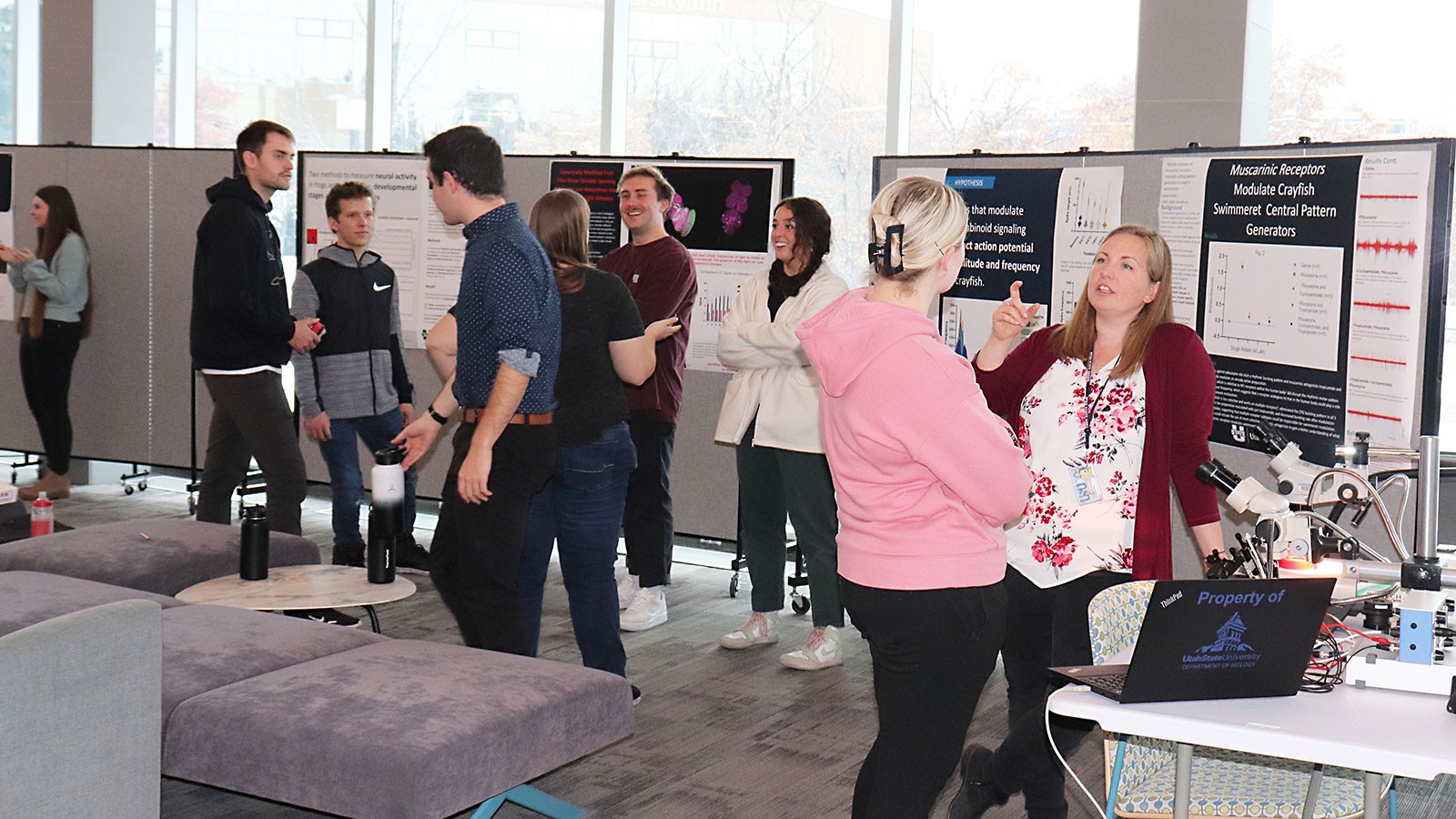Into the Brain: Student Poster Session Highlights New USU Neurophysiology Lab Course
Biology faculty member Sara Freeman and students share research projects along with techniques used in a new class offering.
By Mary-Ann Muffoletto |
Doctoral teaching assistant Megan Raddatz, standing, assists undergrad Kaleb Keller at a recording rig from the BIOL 5625 neurophysiology lab class. Students in the new course held a poster session Dec. 7. (Photo Credit: USU/M. Muffoletto)
Exploring the physiology of the brain and nervous system was an opportunity Utah State University undergraduate Kinsley Batson didn’t want to miss.
“I heard about the new BIOL 5625 Neurophysiology Lab course while planning my fall schedule,” says the aspiring neurosurgeon. “I love brains and I loved the idea of being able to develop my own research project.”
Batson, a human biology and sociology major, was among seven scholars from USU Biology faculty member Sara Freeman’s inaugural BIOL 5625 class this past fall semester. The students presented posters about their class research projects during a public session Dec. 7 in the Biology-Natural Resources Building atrium.
“We organized a casual gathering to give class participants an opportunity to present their research and for others on campus to learn more about the course,” says Freeman, assistant professor of neurobiology in USU’s Department of Biology. “We plan to offer this class each fall.”
Freeman developed the course in response to the increasing demand for more neuroscience offerings for undergraduates. Equipment funding for the class came from USU sources, as well as a grant awarded to Freeman by Faculty for Undergraduate Neuroscience (FUN), an international organization supporting neuroscience research and education at the undergraduate level.
Freeman secured “recording rigs” — workstations including a microscope, amplifier, stimulator, electrodes, laptop computer and analytical software — used to record, visualize and analyze the electrical activity from live neurons.
Demonstrating a rig at the poster session, Freeman explained she currently has four rigs, essential equipment for the lab course, which enable her to accommodate up to eight students in a class.
“I hope to add more rigs, which will allow more students to enroll in the class,” she says. “Each rig costs about $15,000, so it would require a substantial financial contribution.”
At the poster session, undergraduate Kaleb Keller used a rig to explain his research, through which he was able to determine that receptors for the neurotransmitter acetylcholine are involved in rhythmic firing patterns in the crayfish nervous system.
“The drugs I used in the study, including cyclopentolate and tropicamide, are in eye drops for pupil dilation routinely used during ophthalmic examinations, including at the eye clinic where I work,” says Keller, a human biology major, who plans to attend optometry school. “It’s been really interesting to learn about the mechanism of these drugs and how they affect nervous system responses.”
Kora Lynn, an undergraduate human biology major, says she was “hooked on the course” from the first class meeting.
“Dr. Freeman and Megan Raddatz are amazing,” says Lynn, who plans to pursue osteopathic medicine. “Having the opportunity to try varied lab techniques and participate in original research has been very beneficial and super interesting.”
Freeman and Raddatz say developing an advanced lab course from scratch was a challenge, but they’ve encouraged students to “learn along with them.”
“This is real science,” says Freeman, who was named the College of Science’s 2022 Undergraduate Research Mentor of the Year. “Sometimes you experience ‘productive failures,’ which are good obstacles for students to confront and learn to overcome.”
She says the course is an excellent choice for students undertaking life sciences studies, including biology, psychology, neuroscience, biochemistry, kinesiology and biological engineering majors.
“The class provides opportunities to dig into research and to determine interest in future academic paths, including graduate school or medical school,” she says. “The course is offered for both undergraduate and graduate students.”
Batson, who dissected a brain and nervous system in the USU Cadaver Lab and has participated in research in USU Biology’s Womack Lab and the university’s Autism and Neurodevelopmental Disorders Lab, says BIOL 5625 has been a perfect complement to her other academic efforts.
“It’s reinforced my desire to study medicine and neuroscience, in particular,” she says. “This class is so hands-on and research-intensive. I feel better prepared to go forward in medical studies with the knowledge and lab experience I’ve gained.”
Biology faculty member Sara Freeman, far right, talks with a visitor at the Dec. 7 BIOL 5625 neurophysiology poster session at USU. The new course was created to accommodate increasing demand for neuroscience offerings. (Photo Credit: M. Muffoletto)
WRITER
Mary-Ann Muffoletto
Public Relations Specialist
College of Science
435-797-3517
maryann.muffoletto@usu.edu
CONTACT
Sara Freeman
Assistant Professor
Department of Biology
435-797-0670
sara.freeman@usu.edu
Comments and questions regarding this article may be directed to the contact person listed on this page.









